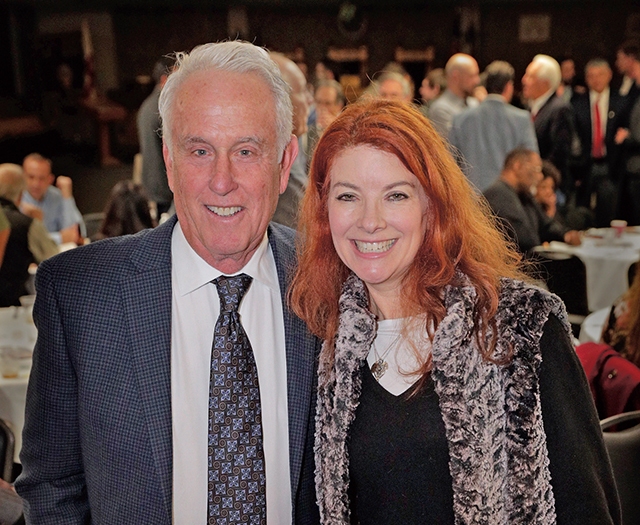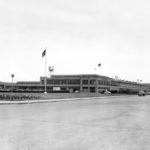Ken Korach with Susan Slusser.
The Oakland A’s radio guy has a new book out with Susan Slusser that’s full of A’s lore. FB:
Since arriving in 1968, the Oakland A’s have spent a fair amount time talking about moving to greener pastures. Thankfully, that’s changed in recent years and the team, as evidenced by the “Rooted in Oakland” mantra, is committed to staying in Oakland. One guy who definitely isn’t going anywhere is the team’s radio guy, Ken Korach. For the last 23 years, he’s confidently described everything from routine ground outs to grand slams in an easy going style with just a touch of his idol, recently retired Dodger announcer Vin Scully, thrown in for good measure. Korach, along with the San Francisco Chronicle’s longtime A’s beat writer Susan Slusser, have put together a tome of A’s lore entitled If These Walls Could Talk: Stories from the Dugout, Locker Room, and Press Box. The book is done mostly in interview style, with the pair talking to everyone from A’s legend Rickey Henderson to lifelong fan and Pixar exec Jonas Rivera. They also reveal their own personal stories: Did you know that as a child Slusser got to ride Charlie-O the Mule? There’s photographic evidence. I caught up with Korach as he prepped for a game with the Orioles recently to get his take on all things A’s.
Paul Kilduff: In a seemingly endless 162-game baseball season, how do you keep that professional distance with the team?
Ken Korach: I think the thing for me is that it comes down to credibility. And at the core, I’m a professional broadcaster, so I work for the A’s, but I’ve always tried to adhere to the tenets of our profession. I’m not afraid to say that I want the A’s to win; I think anybody who listens to us knows that. But that doesn’t mean that you can’t do an objective job of calling the game, because it all comes down to trying to be as accurate as possible. Our job is to describe what we see. It’s always bothered me when you hear a great play that’s made by the opposition, and the other team’s announcer calls it like it’s a routine ground ball to short. I want to get excited about great plays whether they’re made by the A’s or somebody else.
PK: It’s fascinating how you, just like Giants announcer, Haywardite Jon Miller, sat in the Coliseum bleachers with tape recorders and recorded your own play-by-play and then got your start at a little radio station up in Petaluma, KTOB. I remember listening to that station when I was a kid (and a lot of other local ones). I grew up in Oakland, but I could still get it, believe it or not. KTOB, as well as a lot of other smaller stations are no longer around, and so it brings up the question: Where do young broadcasters today get started?
KK: I’m so grateful to have had that opportunity at KTOB. It was the greatest education you could ever imagine. I had no training, other than the fact that I always wanted to do this from the time I was like 8 or 9 years old. When I was there, we did anything. I mean, it was the epitome of small market radio. I think there’s more opportunity, and there’s less. There’s less opportunity in small market radio, because those stations are dinosaurs, and that does make it frustrating, but I also think there’s more opportunity if you want to try to get into television, certainly compared to when I came up. When I came up, cable TV was in its embryonic stages, right? And podcasting and things like that. I think if you’re creative, there are more opportunities.
PK: The A’s have made it clear they’d like to build a new stadium at the Howard Terminal site north of Jack London Square. That sounds great, but there’s so many hurdles. Amtrak next door, no parking, and of course, the idea of having gondolas ferry fans from BART. I’m coming around on the idea, but it sounds as difficult as building another stadium.
KK: I know, going over the freeway. Their hope is that it would be almost a tourist attraction; that you could do it year-round. Howard Terminal is almost a little bit of a misnomer, because it’s just up the road from Jack London, only about a five-minute walk. This is just me talking, I don’t want to talk out of school, but there may be some more opportunities around Jack London for parking. If things evolve over the next few years, people could have dinner down there and walk up. My focus is on the games, obviously. That’s my gig. But I’m really hopeful.
PK: The re-signing of Khris Davis, Major League Baseball’s home run king last season for a pretty hefty $16.5 million, is very promising. For once, the A’s didn’t trade a star player because they couldn’t afford him. Has that practice over the years impacted attendance? And do you think that’s changing?
KK: Good question. Initially, we certainly lost a lot of our fans. But it’s very difficult when you’re a fan, and especially if you’re raising your kid who has somebody’s jersey. And now that player gets traded. I quote A’s President Dave Kaval who said the team can’t put their fans through another cycle of developing players and then having them leave. You hope that the fans develop a relationship with your players, that they start to care about their players. Know they’re going to be there year after year. So when there’s constant turnover, that’s a very difficult thing for a fan base, there’s no doubt. That being said, and I’m not trying to be Pollyanish about it, but the A’s had nine post season appearances beginning in 2000. Almost any other franchise, besides maybe the Yankees or Red Sox, would die to have that.
PK: One of the things that I love about Khris Davis — he’s still sporting the knickers. Do you think he’s going to single handedly end the current slob pants/no stirrups era in baseball?
KK: Well, a lot of guys like to wear their pants up high like that.
PK: Is that changing?
KK: It’s been going on for a long time. Honestly, a lot of it goes with how they’re going.
PK: So, it’s a baseball superstition thing.
KK: No doubt. By the way, did you read the chapter about my mom?
PK: Yes, I did.
KK: That was my primary motivation for writing the book.
PK: Really? I wasn’t sure if you wanted to even talk about that. It touched me, personally, because my uncle, whom I was pretty close to, also committed suicide. This was in 1989 and I really didn’t talk about it that much.
KK: It’s a hard thing for people to talk about. It’s a tough place for people to go. But, if some positive could come out of that chapter, and people reading it, then that’ll be a real victory for me, personally.
Ken Korach Vital Stats
Age: 67
What’s your sign, man? Aquarius
Birthplace: Los Angeles
Favorite hot dog topping? “I’m not a big hot dog guy.”
Words to live by: “Being gracious is the most important thing.”
Link to book: TriumphBooks.com/if-these-walls-could-talk–oakland-a-s-products-9781629375809.php
Editor’s note: In “Ken Korach: A Mother’s Legacy,” which is chapter three of the book, Korach describes how the scene after the A’s Dallas Braden pitched his perfect game at the Coliseum on Mother’s Day 2010, nine years after he had lost his own mother to cancer, affected him. Braden’s grandmother, who guided him through the difficult time after his mother’s death, embracing the pitcher on the field brought back memories of his own mother Frances’ suicide in 1973. “I was fighting back tears and working hard to hold it together,” writes Korach. He goes on to encourage those contemplating suicide to seek help and those affected by it to talk about it.
Got an idea for The Kilduff File? E-mail Paul Kilduff at [email protected].
This article originally appeared in our sister publication, The East Bay Monthly.
















